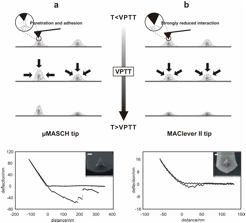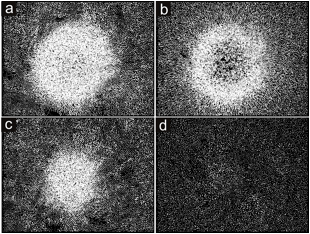

43930-AC5
Designed Thin Films from Core/Shell Microgel Particles
<>Introduction: Scientific and Educational Impact
The focus of this program has been the development of functional colloidal assemblies from hydrogel micro- and nanoparticle building blocks. A series of studies on microgel assemblies are reported, wherein optical microscopy, quartz crystal microgravimetry (QCM), surface plasmon resonance (SPR), and atomic force microscopy (AFM) have been used to probe the properties of colloidal assemblies as a function of environmental factors and the details of the assembly process. Our findings suggest that: (1) microgel particles represent excellent reservoirs for drug loading and delivery, and that the release properties can be investigated by simple 1H NMR measurements, (2) the interaction between the negatively charged microgels and the positively charged PAH has a significant impact on the pH responsivity of the film, (3) AFM can be used to interrogate the thermosensitivity of individual microgel particles in a quantitative manner, and (4) co-assembled microgels and Au nanoparticles can assemble into ordered photonic crystals, and that the resultant assembly can be manipulated optically.
These studies have advanced the fundamental understanding of microgel assembly physics. By bringing to bear a number of analytical tools to study the problem, we have painted a picture of these materials that has been previously unclear.
<>Microgels for Drug Delivery
<>We have used pNIPAm-co-AAc (AAc) microgels as reservoirs for insulin loading, and have elucidated the temperature dependence of microgel deswelling and its correlation with insulin release. For example, 1H NMR based interrogation of insulin release was investigated as a function of loading method (equilibrium partitioning vs. active microgel swelling). Figure 1 presents representative data that show completely different temperature dependent release profiles for the two cases, suggesting that the "breathing-in" technique for loading actually causes the microgels to imbibe the insulin, whereas the equilibrium loading method results in weak adsorption to the particle surface.
<>Microgel Multilayer Thin Films
Microgel polyelectrolyte multilayer thin films have been developed, wherein QCM, SPR, AFM have been used to probe their properties as a function of film architecture and solution pH. Our findings suggest that the interaction between negatively charged microgels and linear polycations has a significant impact on the pH responsivity of the film. These effects are observable in both the optical and mechanical behaviors of the films. Scheme 1 illustrates the observed "bimodal" swelling mechanism, wherein a decrease in pH results in swelling of the film bulk and a concomitant deswelling of the film surface.
AFM Imaging of Single Microgels
The volume phase transition (VPT) behavior of individual pNIPAm-co-AAc microgels was studied by in-situ dynamic mode AFM and force spectroscopy during heating and cooling cycles. The imaging parameters were studied as a function of tip shape and imaging mode, revealing a dramatic dependence of tip shape and material. Elasticity measurements performed at single particles at temperatures below and above the VPT revealed a 15-fold increase in Young's modulus after passing the VPT indicating the transition from a soft, swollen network to a stiffer, deswollen state. Figure 2 illustrates the operative conditions that result in a dramatic tip shape dependence on imaging.
<>Laser-Controlled Phase Transitions
PNIPAm microgels were co-assembled with Au nanoparticles into disordered 3-D glassy phases and irradiated with a tightly focused laser (λ=532 nm) to study crystallization dynamics following a localized photothermal annealing process. The degree of crystallization produced by the annealing process is dependent upon heat flux into the sample at the site of irradiation, the length of irradiation time, and the temperature of the surrounding bulk assembly that functions as a quenching bath. Figure 3 shows particle trajectories associated with assembly relaxation following irradiation. These quantitative particle tracking methods provide for a detailed view of assembly dynamics and energetics.
Figure 1. Plots of the normalized ratios of (a) pNIPAm/acetone and (b) insulin/acetone as a function of
temperature. Open circles represent microgels loaded
by the breathing-in method; open squares represent microgels
loaded via equilibrium partitioning.
Scheme 1. Schematic depiction of the bimodal
swelling model.
Figure 2. Proposed models for tip-sample interaction between µMasch tips (a) and MAClever II
tips (b), and deflection-distance curves recorded with the respective tips at
25 °C (bottom). Insets show SEM images of the probes (scale bar
corresponds to 5 µm). (a) Force spectroscopy shows large (up to 8 nN) and wide ranged (200-300 nm) adhesive forces
between µMasch tips and hydrogel
particles at 25 °C (µMasch tip force constant:
0.0754 N/m). (b) Force spectroscopy shows reduced adhesive forces between MAClever II tips and microgels (MAClever II tip force constant: 0.2007 N/m).
Figure 3. Partial particle trajectories during
the cooling process started immediately after laser irradiation was ceased for
(a) and (c) a 6.20 wt % microgel sample, and (b) and
(d) a 8.02 wt% sample. Trajectories (a) and (b) are the first 15 s and (c) and
(d) the last 15 s of each 75 s movie.



